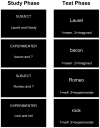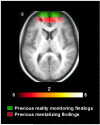Separable forms of reality monitoring supported by anterior prefrontal cortex
- PMID: 18004946
- PMCID: PMC2292823
- DOI: 10.1162/jocn.2008.20036
Separable forms of reality monitoring supported by anterior prefrontal cortex
Abstract
Reality monitoring refers to the process of discriminating between internally and externally generated information. Two different tasks have often been used to assess this ability: (a) memory for perceived versus imagined stimuli; and (b) memory for participant- versus experimenter-performed operations. However, it is not known whether these two reality monitoring tasks share neural substrates. The present study involved use of a within-subjects functional magnetic resonance imaging design to examine common and distinct brain mechanisms associated with the two reality monitoring conditions. The sole difference between the two lay in greater activation in the medial anterior prefrontal cortex when recollecting whether the participant or the experimenter had carried out an operation during prior encoding as compared to recollecting whether an item had been perceived or imagined. This region has previously been linked with attending to mental states. Task differences were also reflected in the nature of functional connectivity relationships between the medial anterior and right lateral prefrontal cortex: There was a stronger correlation in activity between the two regions during recollection of self/experimenter context. This indicates a role for the medial anterior prefrontal cortex in the monitoring of retrieved information relating to internal or external aspects of context. Finally, given the importance of reality monitoring to understanding psychotic symptoms, brain activity was related to measures of proneness to psychosis and schizotypal traits. The observation of significant correlations between reduced medial anterior prefrontal signal and scores on such measures corroborates these theoretical links.
Figures





References
-
- Bentall RP, Baker GA, Havers S. Reality monitoring and psychotic hallucinations. British Journal of Clinical Psychology. 1991;30:213–222. - PubMed
-
- Burgess PW, Shallice T. Confabulation and the control of recollection. Memory. 1996;4:359–411. - PubMed
-
- Burgess PW, Simons JS, Dumontheil I, Gilbert SJ. The gateway hypothesis of rostral prefrontal cortex (area 10) function. In: Duncan J, Phillips L, McLeod P, editors. Measuring the Mind: Speed, Control, and Age. Oxford: Oxford University Press; 2005. pp. 217–248.
-
- Chapman LJ, Chapman JP, Raulin ML. Scales for physical and social anhedonia. Journal of Abnormal Psychology. 1976;85:374–382. - PubMed
-
- Chapman LJ, Chapman JP, Raulin ML. Body-image aberration in schizophrenia. Journal of Abnormal Psychology. 1978;87:399–407. - PubMed
Publication types
MeSH terms
Substances
Grants and funding
LinkOut - more resources
Full Text Sources

